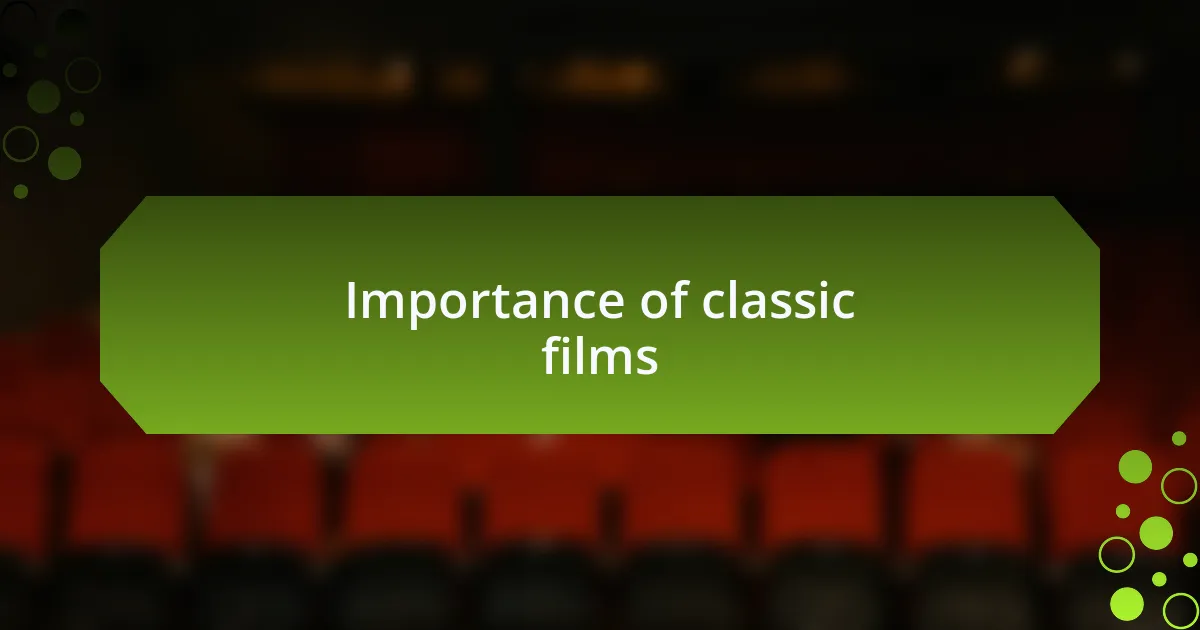Key takeaways:
- Movie streaming services offer diverse options, enhancing access to global cinema and unique storytelling styles.
- Classic films are pivotal in understanding historical contexts and universal themes that resonate across generations.
- Foreign classic films challenge conventional storytelling and provide insights into different cultures and experiences.
- Creating the right viewing environment and embracing subtitles can significantly enhance the enjoyment of foreign films.

Understanding movie streaming services
When I first dove into movie streaming services, I was overwhelmed by the sheer number of options available. Each platform seems to offer something unique, from classic films to the latest blockbusters, but how do you choose the right one? It’s like standing in front of a candy store – so many enticing choices, yet challenging to pick just one.
I remember the moment I discovered a lesser-known streaming service that specialized in international films. It felt like unearthing a hidden gem! This experience opened my eyes to the beauty of global cinema, igniting a passion for foreign classics that I hadn’t fully appreciated before. With the right streaming service, you can traverse different cultures and perspectives without ever leaving your home.
Understanding the nuances of these platforms can also enhance your viewing experience. For instance, some services focus more on indie films, while others might emphasize mainstream titles. Have you ever thought about what genres resonate with you the most? By exploring various platforms, you can find a service that aligns perfectly with your taste, allowing you to enjoy films that truly speak to your heart.

Importance of classic films
Classic films hold a unique power in storytelling and artistry that influences generations of filmmakers. I remember watching “Casablanca” for the first time; it felt like stepping into a time capsule infused with emotions and cultural reflections from an era long past. This exposure doesn’t just teach us about cinema; it connects us to the historical moments and societal issues that shaped those narratives.
The importance of classic films extends beyond entertainment; they serve as a benchmark for creativity and innovation. Take “The Wizard of Oz,” for instance; its use of color, music, and special effects was groundbreaking. Watching these classics invites me to appreciate the artistry that paved the way for contemporary films, igniting discussions on how storytelling has evolved over the years.
Additionally, classic films often encapsulate universal themes that resonate across cultures and contexts. Reflecting on “8½” by Federico Fellini, I find that its exploration of self-doubt and creative struggle remains relevant to anyone pursuing their passion. Don’t you think that revisiting these stories can deepen our understanding of both ourselves and the human experience? Classic films encourage such introspection, making them invaluable in our cinematic exploration.

Overview of foreign classic films
Foreign classic films present a vibrant panorama that transcends borders and languages, revealing diverse cultural narratives. When I first encountered Jean-Luc Godard’s “Breathless,” I was struck by its innovative style and raw energy—a true departure from the mainstream cinema I was used to. This exciting approach not only showcased a different cultural perspective but also challenged my understanding of storytelling conventions. Have you ever felt that thrill when a film surprises you in unexpected ways?
These films often serve as windows into the societal and historical contexts of their time, allowing us to understand complex worldviews. Watching Akira Kurosawa’s “Seven Samurai” for the first time, I felt the weight of honor, duty, and sacrifice portrayed across its sprawling narrative. The film transports you to feudal Japan, but more importantly, it makes you reflect on the values that persist in our society today. Isn’t it fascinating how these timeless messages resonate even decades later?
Exploring foreign classics is akin to embarking on a journey through varied landscapes of human emotion and cultural complexity. Films like “La Dolce Vita” by Fellini immerse you in luxurious visuals and profound existential questions, leading to contemplative moments long after the credits roll. Isn’t it enriching to discover how stories from different corners of the globe can evoke similar feelings and thoughts, reminding us of our shared humanity?

Benefits of exploring classic films
Diving into classic films presents a unique opportunity to appreciate the art of storytelling in its purest form. I remember the first time I watched Fritz Lang’s “Metropolis”—the visual artistry was striking, but it was the underlying themes of class struggle and technology that left a lasting impression. Have you ever found a film that made you think critically about issues you hadn’t considered before? That’s the power of these classics; they engage you on multiple levels.
Moreover, exploring foreign classics broadens our cinematic horizons and deepens our appreciation for different filmmaking techniques. When I saw Satyajit Ray’s “Pather Panchali,” the delicate portrayal of rural life in India was both beautiful and heartbreaking. I couldn’t help but think about how much I had taken for granted in my own life. Isn’t it remarkable how a film can open your eyes to realities that exist far beyond your everyday experiences?
Classic films often encourage us to reflect on our shared human experiences, regardless of cultural background. Watching “The Seventh Seal” by Ingmar Bergman sparked a deep existential ponder for me—its powerful exploration of faith and mortality was both unsettling and thought-provoking. Does film not have that unique ability to connect us to our own humanity? Engaging with these works allows us to confront universal themes that resonate across generations, ultimately enriching our understanding of life itself.

My favorite foreign classic films
One of my favorite foreign classic films has to be Federico Fellini’s “La Dolce Vita.” The juxtaposition of the glamorous and the mundane in post-war Italy captivated me. I remember feeling a mix of awe and reflection as I watched Marcello’s journey—a vivid reminder of how fleeting happiness can be. Have you ever found yourself drawn to a story that mirrors your own complexities?
Then there’s Akira Kurosawa’s “Rashomon,” which profoundly impacted my view on perception and truth. The innovative narrative structure had me questioning the very nature of reality and memory. I found myself pondering: can we ever truly understand someone else’s perspective? The conversations this film sparked in my circle were delightful, revealing just how many interpretations one story can ignite.
Lastly, I have a deep appreciation for Jean-Luc Godard’s “Breathless.” Its audacious editing style and dynamic storytelling were nothing short of revolutionary when I first watched it. I still remember the thrill of witnessing a film break conventions; it felt liberating. Isn’t it fascinating how some movies push boundaries and redefine what cinema can be? Exploring these films continues to inspire my love for the art, reminding me that there’s always more to discover.

Tips for streaming foreign films
When diving into foreign films, it’s essential to set the right mood. I recall one evening when I decided to turn off the lights, make some popcorn, and really immerse myself in “A Bout de Souffle” by Jean-Luc Godard. The entire experience was enhanced by creating a cozy atmosphere—it’s interesting how a simple environment shift can elevate your engagement with the film. Have you ever noticed how distractions can pull you out of a story?
Another tip is to embrace subtitles as part of the experience rather than a barrier. When I first started watching films in different languages, I found it challenging to read and absorb the visuals simultaneously. However, over time, I realized that subtitles can add a layer of depth, helping to convey nuances in dialogue that you might miss otherwise. Have you ever felt like you understood a character’s emotions better because of the subtleties in the translation?
Lastly, consider exploring the cultural context behind the films. I remember learning about the political climate surrounding “The Lives of Others” before watching it, which significantly heightened my appreciation for the narrative. It made me realize how much richer a film can be when you grasp its historical background. What about you? Have you ever watched a film and later discovered its deeper implications, making the viewing experience even more profound?